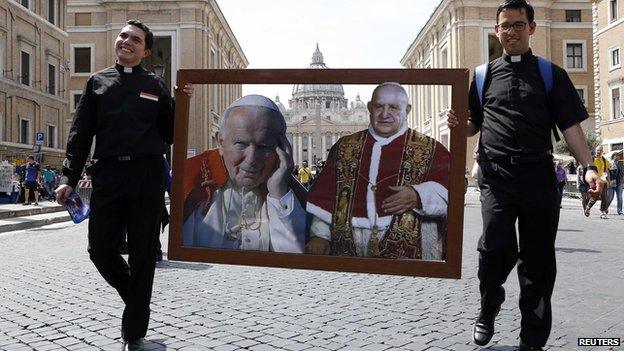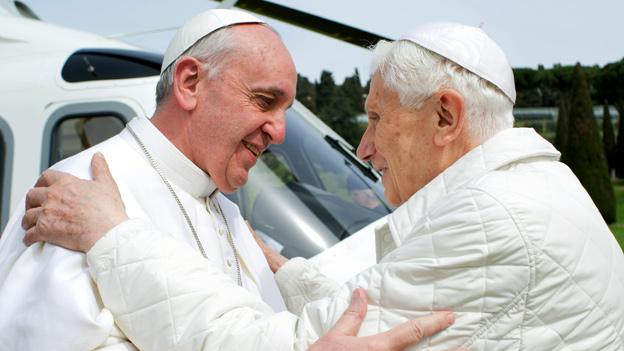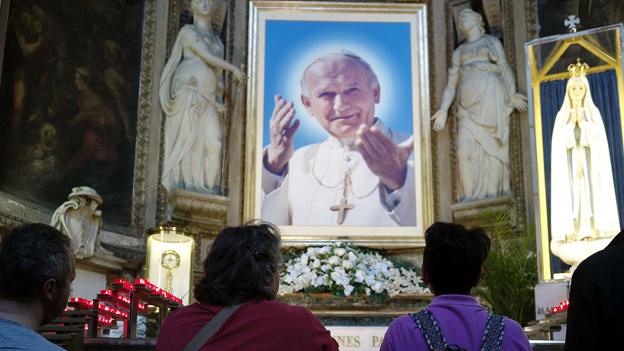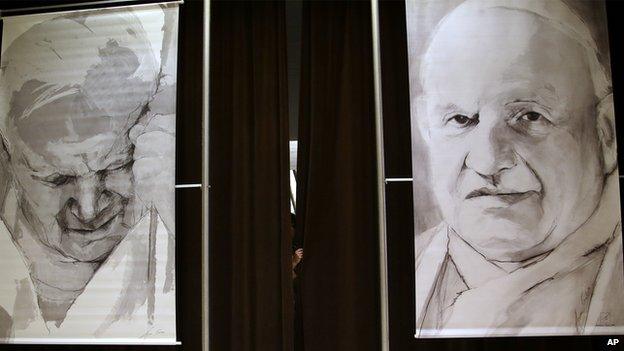Sainthood 'spectacular' draws faithful to the Vatican
- Published

The two new saints are drawing thousands of Catholics to the Vatican for a celebration
St Peter's Square this weekend becomes the stage for one of the most spectacular events ever celebrated by the Roman Catholic Church.
The Vatican will hold the simultaneous canonisation by Pope Francis of two 20th-Century popes, who led the transition of the world's oldest international organisation into the modern world - John XXIII and John Paul II.
Former Pope Benedict, now in retirement, is also expected to be present.
The stresses and strains of bringing the Catholic Church up to date - amid accusations of clerical sexual scandal, a growing problem of recruiting new priests, the flight from the pews in Europe and North America, and the general shift of the Church towards the developing world - are still being worked out by Pope Francis.
He will preside over a two-hour ceremony expected to attract more than 50 heads of state and government and more than a million faithful to the Church's hub - the tomb of the Apostle Peter, the first Pope.
For the first time in history, two living popes, Francis and former Pope Benedict, will be witnessing the raising to the altars of two of their dead predecessors.

Pope Francis (left) and Pope emeritus Benedict XVI will honour two predecessors
'Santo subito!'
The saint-making process is usually long and very costly, as it involves elaborate investigation of the lives of the men and women chosen for the future veneration of the world's Catholic believers.
In the early Church, saints were often chosen by popular acclaim. But over the centuries the Vatican has created a specific department to supervise the business of deciding who is to benefit from the posthumous ecclesiastical honours system.
Saint John Paul, who created more new saints and blesseds during his lifetime than any of his predecessors, has been fast-tracked to sainthood only nine years after his death. (The difference is that a saint is venerated by the worldwide church, while a blessed is venerated locally.)
The crowds that gathered as John Paul lay dying cried out "Santo subito!" (Make him a saint immediately!)

John Paul II - from Poland - reigned at a time of turmoil as communism declined in his homeland

Portraits of the much-loved popes at a Vatican press briefing - John XXIII is on right
Reformer
Saint John, a hugely popular friendly and genial roly-poly priest-diplomat from a humble Italian peasant background, has gone down in history as "the Good Pope". He also was deeply mourned around the world when he died in 1963, but his promotion to full sainthood was decided suddenly and very recently by Pope Francis.
There was a political dimension to this. Many Catholics regret their Church's subsequent failure fully to implement the radical reforms promised by the Second Vatican Council half a century ago.
By canonising both the Pope who set off the reform movement and the Pope who applied the brakes, declaring for example that hot-button issues such as the celibacy rule and the ordination of women as priests were not up for discussion, Pope Francis has skilfully deflected any possible criticism that he could be taking sides.
It was Saint John XXIII who made the bold decision to summon all the world's bishops to Rome for the Second Vatican Council in 1962. When he was elected he was expected to be a transitional figure after the death of the now controversial wartime Pope Pius XII. But he turned out to be one of the greatest forces for change in the Church in modern times, despite his relatively short five year reign.
Travelling the world
Saint John Paul II, on the other hand, reigned longer than practically any other pope in history - just over 26 years.
It was my peculiar fortune to be the witness of many of his triumphal overseas journeys. I saw him kneel to kiss the ground as he arrived back for the first time on a visit to his native Poland.
And I witnessed the long, slow decline in his health to the point when he was barely able to descend the aircraft steps, let alone stoop to kiss the earth.
As Rome correspondent for the BBC I travelled as a member of the Vatican Press on the papal charter plane on some 50 foreign trips, which took the new saint and his Vatican retinue to the four corners of the Earth.
Paradoxically we had closer access to John Paul than many Vatican officials during these often gruelling journeys, all over Africa and South America and even further afield. We touched down in most of the world's capitals, with the exception of Moscow and Beijing.
He spoke six languages fluently and several others, including English, less well, and during long flights over the Atlantic and Pacific oceans he used to wander through the back of the plane and chat quite freely with us.
I remember on one occasion being surprised by the new saint as I was strapped in my seat, having my breakfast shoeless and tieless. I asked him how he managed to keep up the pace of these long journeys after the attempt on his life, which had taken its toll on his health.
"That's easy to explain," he said, pointing upwards with his finger. "Management from above!"